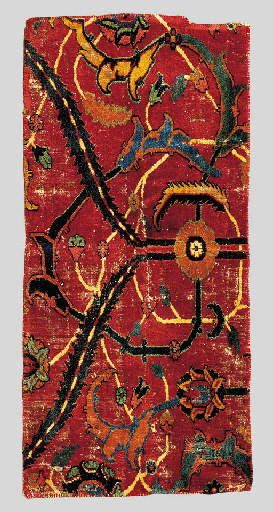|

|
A KHORASSAN CARPET FRAGMENT
North East Iran, mid-17th Century
The burgundy field with brightly coloured scrolling split palmette and
arabesque vine overlaying thin white tendrils issuing floral motifs and
itself overlaid by paired sea-green serrated leaves linked by a rosette
probably originally forming a lattice, slight wear and minimal repair,
backed
1ft.5in. x 3ft. (43cm. x 92cm.)
Provenance: Dikran Kelekian Collection, sold Parke Bernet Galleries, New
York, 21-23 October 1953, lot 618.
Literature: Migeon, Gaston: La Collection Kelekian, Étoffes et tapis, Paris,
1909, pl.9.
Exhibited: L'Institut du Monde Arabe, Paris, 1989-1994.
Sale Information
Christie's Sale 6435
ORIENTAL RUGS AND CARPETS
3 May 2001
London, King Street
Price Realized £7,638 ($10,960)
Lot Notes
Were it not for the jufti knotting and the soft wool this fragment might be
taken for an Isfahan rug. Certainly the colour scheme is directly taken from
there. But the design, despite its similar constituent parts comprising
spiralling tendrils issuing arabesques and palmettes, is certainly
different. While it is difficult to be certain of the whole design from this
fragment, it is clear that it involves three overlaid structures, but not in
the same mathematical way that the three structures work in the classic
'vase' carpets from Kirman. The system here of bold serrated blue leaves,
probably originally forming an ogival lattice, is designed over two separate
systems of interlaced scrolling blue and white tendrils. Another unusual
feature is that the split palmettes, instead of forming terminals, at times
are just elements along the path of a scrolling line which continues from
the top of the larger of the two parts.
The pile in this fragment is in very good condition, retaining the lustre
and depth of colour from its time of manufacture. This is particularly
remarkable in that the red ground has not substiantially corroded.
|

